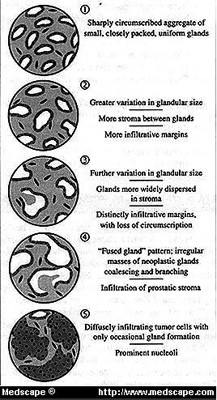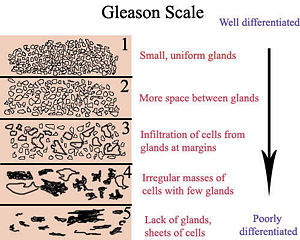Understanding the Gleason Scale
Author: Brian Hildebrandt, Last Updated: Sept. 2, 2019
The gleason scale is an important diagnostic tool to assess the progression of prostate cancer.
If your PSA test results and/or DRE (digital rectal exam) come up positive, the next course of action is usually a prostate biopsy (surgical removal of a small section of prostate cells).
The results of this test is referred to as your Gleason score.
Gleason grading is a well established diagnostic tool, your doctor can use to help direct your future treatment.

How the Gleason Scale is Calculated
The scale (1-5) is made up of a Gleason grade (1, 2, 3, 4, 5) from your prostate biopsy.
1 being the least aggressive and looking mostly like normal prostate cells, and 5 being the most aggressive and looking mostly like irregular prostate cancer cells.
The scores are based on combining the grades of two differant biopsy sections (primary and secondary).
The primary section (at least 50% of biopsy) which is graded from 1 to 5.
And the secondary section (5% to 50% of biopsy), also graded from 1 to 5.
Therefore your score consists of 2 Gleason scale grades;
1 to 5 (primary) + 1 to 5 (secondary) = 2 to 10.
i.e. 4 + 3 = 7. A GS of 7.
Gleason Scale Levels
- Low Grade (well differentiated): 4 or less.
- Intermediate Grade (moderately differentiated): 4 to 7.
- High Grade (poorly differentiated): 8 to 10.

Low Gleason Score: 4 or Less
Your biopsy test results indicate prostate cancer cells that still look like regular prostate cells and will tend to spread slowly.
Intermediate Gleason Test Score: 4 to 7
Your prostate cancer cells look somewhat like regular prostate cells but there are noticable differances, and may tend to spread at a faster rate.
High Gleason Prostate Score: 8 to 10
Your prostate cancer cells have clear indications of irregular shape and size, and may spread at a fast rate.
Pathological Differences: (3,4) vs (4,3) at RP (Radical Prostatectomy)
| Clinical-Pathological Finding | GS 3+4 | GS 4+3 |
|---|---|---|
| Extra-prostatic Extension at RP (established) | 38.2% | 52.7% |
| 5-year Actuarial Rate of Progression post-RP | 15% | 40% |
| 10-year Actuarial Rate of Progression post-RP | 37% | 56% |
| Time to Progression (years) | 4.4 | 3.2 |
| Development of Metastatic Disease | 3.7% | 10.5% |
Reference: Table adapted from – Chan TY, Partin AW, Walsh PC, et al: Prognostic significance of Gleason score 3+4 versus Gleason score 4+3 tumor at radical prostatectomy. Urology 56:823-827, 2000.
Prostate Cancer Treatment Options
Which treatment you and your doctor decide upon will depend on both your Gleason test scores and stage of prostate cancer.
The factors on whether the prostate cancer has spread outside your prostate gland and it’s rate of growth, are the major determinants on deciding your best treatment approach and survival rates.